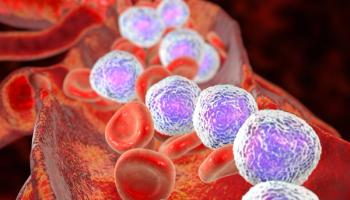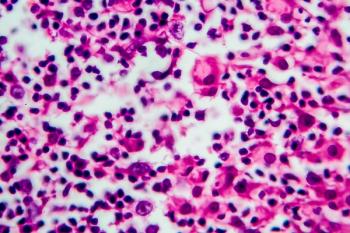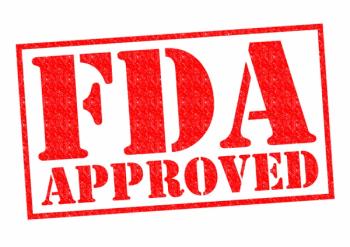
- February 2021
- Volume 27
- Issue 2
Interview: Tanya Siddiqi, MD, Discusses the Promise of Reduced Toxicity With Liso-Cel

Tanya Siddiqi, MD, director of the chronic lymphocytic leukemia program at Toni Stephenson Lymphoma Center provides insights on what the arrival of liso-cel could mean in the treatment landscape.
More than 3 years after the FDA approved the first options in chimeric antigen receptor (CAR) T-cell therapy, Bristol Myers Squibb (BMS) and Juno Therapeutics received word February 5, 2021, that lisocabtagene maraleucel (liso-cel) was approved for the treatment of relapsed or refractory (R/R) large B-cell lymphoma, following progression after at least 2 prior therapies.1
The approval for liso-cel, to be sold as Breyanzi, followed a lengthy approval process that saw the termination of a contingent value rights (CVR) agreement. That deal would have paid investors if the FDA approved liso-cel by December 31, 2020.On November 16, 2020, BMS announced that the FDA would not meet its target approval date due to the agency’s inability to complete inspections at a third-party manufacturing site, because of travel restrictions related to the coronavirus disease 2019 (COVID-19) pandemic.2
Like its predecessors, liso-cel targets CD19, a surface glycoprotein seen in B-cell development that remains present when the cells become malignant. According to information from BMS, the liso-cel CAR mechanism features the following:
- an anti-CD19 single-chain variable fragment targeting domain for antigen specificity
- a transmembrane domain
- a 4-1BB costimulatory domain intended to increase T-cell proliferation and persistence
- a CD3-zeta T-cell activation domain
In addition, liso-cel’s distinct manufacturing process creates a defined composition of CD8+ and CD4+ T cells, which may reduce product variability; however, the drugmaker states, “The clinical significance of defined composition is unknown.”3
During the JP Morgan conference on January 11, 2021, BMS CEO Giovanni Caforio, MD, said he was “confident” in the future of liso-cel as a “differentiated” CAR T-cell therapy.4 Along with the approval, BMS launched Cell Therapy 360, an online program that gives updates for patients and physicians on when they can expect their CAR T therapy to arrive to their treatment center, along with support services. Patients treated with liso-cel will be able to monitor their condition post-infusion with disposable wearable technology connected to a smartphone, according to an email from BMS.
For insights on what the arrival of liso-cel could mean in the treatment landscape, Evidence-Based Oncology™ (EBO) turned to Tanya Siddiqi, MD, director of the chronic lymphocytic leukemia program at Toni Stephenson Lymphoma Center and associate clinical professor, Department of Hematology & Hematopoietic Cell Transplantation, at City of Hope in Duarte, California.
Siddiqi was an investigator for ZUMA-1,5 which led to the approval of axicabtagene ciloleucel (axi-cel), sold as Yescarta, and the TRANSCEND NHL trial6 for liso-cel. She has addressed major scientific meetings on the challenge of managing the toxicities associated with CAR T-cell therapy—and discussed how liso-cel represents a step forward over its predecessors.
This interview, conducted before the BMS announcement, has been edited for clarity and length.
EBO: We're anticipating an FDA decision on liso-cel before the end of the year. Can you discuss the need of the patients who would take this new CAR T-cell therapy?
Siddiqi: So, for CAR T-cell therapy targeting CD19-positive B-cell lymphomas—specifically aggressive B-cell lymphomas—we already have a couple of FDA-approved options. The question is: what is liso-cel? How is it different? Why would people pick this over other things? In the trials that we've conducted, we found that liso-cel seems to have lesser toxicity in terms of the specific CAR T-cell side effects of cytokine release syndrome or hyper-inflammation, as well as neurotoxicity. We've just seen fewer severe adverse events so much so that at some [cancer] centers across the country, we’ve been able to give liso-cel CAR T-cells to patients in the clinic or outpatient setting rather than having to admit them to the hospital , depending on the patient's situation.
Those are the strengths of liso-cel—less toxicity and thus, a better chance of giving it in the outpatient setting with hospital admission available to anyone who develops a fever or other side effects. This means fewer days of inpatient hospitalization for these patients, so it may be less costly overall. I don’t think the efficacy is necessarily different—meaning that it seems to work as well as the other FDA-approved products already commercially available. But for the reasons that I've listed, I think it might be a very good option for older patients, maybe patients who are bit more frail, or younger patients who just don't want to be admitted to the hospital—they just want to try to do it in the outpatient setting.
EBO: You touched on this already, but can you discuss how Iiso-cel differs from earlier CAR T-cell therapies—both in the way it's manufactured and how it works, and what that reduced variability means for patients?
Siddiqi: Liso-cel is manufactured in a way that it gives very precise, equal numbers of CAR cells that are labeled CD4 and CD8, in a 1:1 ratio. All of us have T cells to fight infections with, and these T cells are what we take from patients. Then, we modify them in the lab by genetic engineering in order to produce CAR T-cells so that now instead of looking for infections, these CAR T cells are going to look for B-cell lymphoma cells and fight lymphoma.
The other products are given back to patients as a bag of CAR T cells mixed with potentially varying ratios of different types of T cells—CD4+, CD8+, etc. With liso-cel the manufacturing process actually separates out the CD4+ and CD8+ types of T cells first, and then manufactures CAR-T cells out of them separately. So, when we give the cells back to patients, we give it in a 1:1 ratio of CD4+ and CD8+ cells. We know exactly how many CD4+ and how many CD8+ T-cells these patients receive. And the thought is, the researchers and the drug manufacturer feel that this helps to have an expectation of what expansion you will have of these cells in the body.
Therefore, we potentially have an idea of what type of side effects or how severe the side effects might be. It may limit some of those side effects, or at least make them a little bit more predictable or controlled.
EBO: That’s a great way to shift to your own work on length of stay due to CRS. What do we know about the key variables in determining whether a patient will experience a side effect that requires an extended stay in the hospital, and can more be done to avoid lengthy hospital stays?
Siddiqi: That's a very important question. Because lengthy hospital stays, especially in the [intensive care unit], really adds to the bill and the financial burden of these treatments. We know that people who have a big burden of disease going into CAR T-cell therapy, meaning they have a lot of lymphoma in their bodies, they tend to be at higher risk for more side effects like cytokine release syndrome and neurotoxicity. Probably because there's so much inflammation that’s generated while these CAR T-cells are trying to fight the lymphoma. What we know is that people who come to us for CAR T-cells with lesser disease might have fewer side effects potentially and a better overall outcome.
So, we always try to advise our referring physicians, and educate patients, at conferences, to try to send these patients to us before they are at the end of the line—before they’ve tried and failed everything, and now there’s just rampant disease. … [At that point,] you're dealing with a situation where the patient is going to have more side effects and will not be able to tolerate the CAR T cells as well. Instead, if they fail two lines of therapy and the disease is still small in volume, but it's starting to progress, we can treat them more effectively with CAR T cells and with fewer side effects potentially.
EBO: That brings up the next topic—there have been discussions that CAR T-cell therapy should be given earlier during treatment. As you said, if it’s not given as the last resort, patients might respond better. Where do you see those patterns heading in the future? And would that be truer for some patients than others?
Siddiqi: With aggressive diffuse large B-cell lymphoma, there's about a 60% to 70% chance of curing that in the frontline setting. With the line of chemo-immunotherapy, you can cure 60% to 70% of patients so that it never comes back. But the rest of them—when it just relentlessly keeps coming back and it's hard to cure—once those patients relapse they tend to keep relapsing. So, our mainstay in the relapse setting is to give them salvage chemo-immunotherapy, collect stem cells, and take them to autologous stem cell transplantation if they've achieved a remission with the salvage chemotherapy. If they haven't achieved remission with that salvage chemotherapy, then they should go on to CAR T cells directly instead of waiting and trying more and more chemotherapies. After failing second line therapy, the FDA approval allows us to try CAR T cells. There are studies that are now ongoing that are comparing CAR T cells to autologous stem cell transplantation after failing first line therapy. So, once patients relapse the first time, these studies are comparing giving them salvage chemotherapy and transplant, versus taking them straight to CAR T cells. Once we have that data, we'll know better whether we can do CAR T cells even earlier in the lines of therapy.
EBO: We’ve been hearing for some time more about allogeneic or “off-the-shelf” therapies. What progress has been made on in that technology?
Siddiqi: I'm not too involved with these trials myself, but I know we have trials at City of Hope that are ongoing with off-the-shelf therapy. What I can tell you is that it's very attractive in that you don't have to collect T cells from patients, keeping their lymphoma under control while these T cells then go to the lab and CAR T cells are manufactured in 2-4 weeks depending on which product it is, and then they come back and get infused. With off-the-shelf products, you can just grab it and go as soon as you know the patient needs it.
The initial concerns were because the cells are not from the patient themselves—the cells are from donors. Across the board there might be concerns of rejection and what's called graft-versus-host disease and things like that. So far, I don't think in the trial they've come up with such side effects to any significant extent. What I don't know is whether they've come up with a good result yet. Is it looking like the benefits of taking off-the-shelf CAR T cells are as good as autologous CAR T cells, meaning patients’ own CAR T cells? I think that remains to be seen. If they are, then it's much easier to use off-the-shelf CAR T cells. Maybe at the American Society of Hematology annual meeting in December we will see more data.
EBO: How is COVID-19 affecting the clinical trial process for CAR T cell therapy?
Siddiqi: When the pandemic kind of started surging early in the year, and when we went into lockdown mode from March onward, we and other centers across the country took a lot of steps to slow down our clinical trial enrollment. Our staff started staggering who would come into work which day of the week and who could work from home. For those in the clinical trials office, there was a lot of need for safety and logistical reasons for us to slow down enrollment onto clinical trials. And there were other questions, such as, who would take care of patients at home once we discharged them after they received CAR T cells? What if their caregivers were exposed and got sick? Logistically, it was difficult to safely do many trials, especially CAR T cell trials and transplants earlier in the year.
Since the end of summer, we ramped up again, and we're now doing as many transplants and CAR T cells as we were probably doing last year. So, we're pretty much all the way up again, but I don't know how this winter will go because COVID is surging again.
As far as just CAR T cells themselves, we had to also think about travel for the cells because Juno Therapeutics is in Seattle, and Kite Pharma is here in Los Angeles, but Novartis is elsewhere. Just the movement of these cells was a concern because of travel restrictions during COVID-19. But as far as I know, the companies did not lose that commitment—they told us, we’ll get the cells to you, we will find a way to do it. I don't think any patients went without cells who should have received cells.
EBO: What advice do you have for community oncologists interested in CAR T cell therapy for their patients?
Siddiqi: There’s good news for community physicians. We may soon have a therapeutic option of liso-cel CAR T cell therapy which seems to have lesser side effects. So, this might make things cheaper due to less need for hospitalization potentially without compromising the chance of cure. We want these patients to try CAR T cell therapy sooner rather than later in their relapses. You can always try multiple cycles of chemotherapy at some other time if you relapse again, but if you can be cured with CAR T cells such that you never need treatment again, why not try that first? For the patients who respond well to CAR T cells, the treatment works extremely well. And that's the Holy Grail – to find the cure for all patients.
Maybe only half the patients will currently have a very good and durable response—but those patients may never relapse again. So why not try it sooner rather than later? And of course, we're always looking for trial patients, because now we need to improve these results even further. So, community oncologists should also refer for trials, because I think that it’s very important to have trials with different combinations—CAR T cells plus another immunotherapy agent—to see if we can improve upon the response rates even more.
References
1. FDA approves new treatment for adults with relapsed or refractory large B-cell lymphoma. News release. Food and Drug Administration. February 5, 2021. https://www.prnewswire.com/news-releases/fdaapproves-new-treatment-for-adults-with-relapsed-or-refractory-largeb-cell-lymphoma-301223275.html
2. Bristol Myers Squibb provides regulatory update on lisocabtagene maraleucel (liso-cel). News release. Business Wire. November 16, 2020. Accessed January 11, 2021. https://www.businesswire.com/news/home/20201116006018/en/Bristol-Myers-Squibb-provides-Regulatory-Update-on-Lisocabtagene-Maraleucel-liso-cel
3. Bristol Myers Squibb provides update on biologics license application (BLA) for lisocabtagene maraleucel (liso-cel). News release. Bristol Myers Squibb. May 6, 2020. Accessed January 11, 2021. https://news.bms.com/news/details/2020/Bristol-Myers-Squibb-Provides-Update-on-Biologics-License-Application-BLA-for-Lisocabtagene-Maraleucelliso-cel/default.aspx#:~:text=Liso%2Dcel%20aims%20to%20target,a%20CD3%2Dzeta%20T%2Dcell
4. Liu A. JPM: Deal-making still a ‘top-priority’ at Bristol Myers as CEO eyes midsize buys. FiercePharma. January 11, 2011. Accessed January 11, 2021. https://www.fiercepharma.com/pharma/jpm-21-m-a-still-a-toppriority-at-bristol-myers-as-ceo-eyes-midsize-deals
5. Neelapu SS, Locke FL, Bartlett NL et al. Axicabtagene ciloleucel CAR T-cell therapy in refractory large B-cell lymphoma. N Engl J Med. 2017;377(26):2531-2544. doi:10.1056/NEJMoa1707447
6. Abramson JS, Palomba ML, Gordon LI, et al. Lisocabtagene maraleucel for patients with relapsed or refractory large B-cell lymphomas (TRANSCEND NHL 001): a multicentre seamless design study. Lancet. 2020;396(10254):839-852. doi:10.1016/S0140-6736(20)31366-0
Articles in this issue
almost 5 years ago
Radiation Oncology’s Role in the Next Chapter of Payment Reformalmost 5 years ago
Flying the Plane While You Build Italmost 5 years ago
The Untapped Potential of Cell and Gene Therapyalmost 5 years ago
Possible Treatment Identified for Aggressive NSCLC SubsetNewsletter
Stay ahead of policy, cost, and value—subscribe to AJMC for expert insights at the intersection of clinical care and health economics.







































